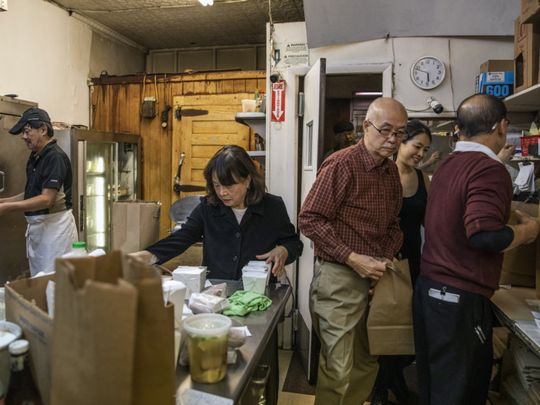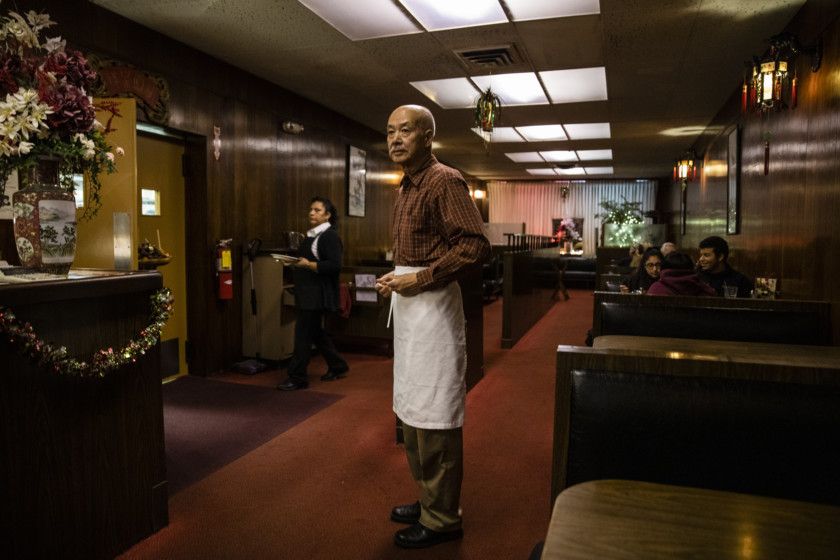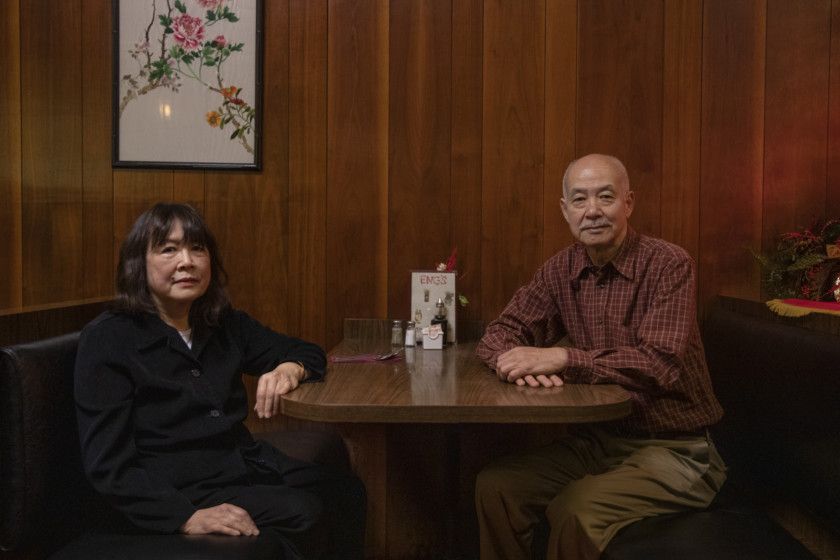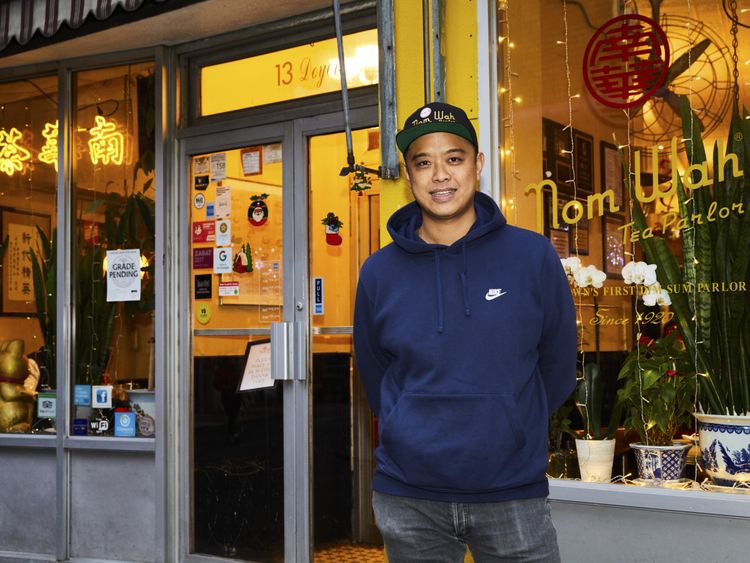
KINGSTON, New York - More than 40 years after buying Eng’s, a Chinese American restaurant in the Hudson Valley, Tom Sit is reluctantly considering retirement.
For much of his life, Sit has worked here seven days a week, 12 hours a day. He cooks in the same kitchen where he worked as a young immigrant from China. He parks in the same lot where he’d take breaks and read his wife’s letters, sent from Montreal while they courted by post in the late 1970s. He seats his regulars at the same tables where his three daughters did homework.
Two years ago, at the insistence of his wife, Faye Lee Sit, he started taking off one day a week. Still, it’s not sustainable. He’s 76, and they’re going to be grandparents soon. Working 80 hours a week is just too hard. But his grown daughters, who have college degrees and well-paying jobs, don’t intend to take over.
Across the country, owners of Chinese American restaurants like Eng’s are ready to retire but have no one to pass the business to. Their children, educated and raised in America, are pursuing professional careers that do not demand the same grueling labor as food service.
1,200 Chinese restaurants fewer today
According to new data from the restaurant reviewing website Yelp, the share of Chinese restaurants in the top 20 metropolitan areas has been consistently falling. Five years ago, an average of 7.3 per cent of all restaurants in these areas were Chinese, compared with 6.5 per cent today. That reflects 1,200 fewer Chinese restaurants at a time when these 20 places added more than 15,000 restaurants overall.
Even in San Francisco, home to the oldest Chinatown in the United States, the share of Chinese restaurants shrank to 8.8 per cent from 10 per cent.
It doesn’t seem that interest in the cuisine has faltered. On Yelp, the average share of page views of Chinese restaurants hasn’t declined, nor has the average rating.
And at the same time, the percentages of Indian, Korean and Vietnamese restaurants - many of which were also owned and operated by immigrants from Asian countries - are holding steady or increasing nationwide.
The restaurant business has always been tough, and rising rents and delivery apps haven’t helped. Tightening regulations on immigration and accounting have also made it harder for cash-based restaurants to do business.
But those are not Chinese-restaurant-specific factors, and do not explain the wave of closings. Instead, a big reason seems to be the economic mobility of the second generation.
Why is a closing down a sign of success?
“It’s a success that these restaurants are closing,” said Jennifer 8. Lee, a former New York Times journalist who wrote of the rise of Chinese restaurants in her book “The Fortune Cookie Chronicles” and produced a documentary, “The Search for General Tso.” “These people came to cook so their children wouldn’t have to, and now their children don’t have to.”
The retirements of the restaurant owners also reflect the history of Chinese immigration to the United States. In 1882, the Chinese Exclusion Act halted what had been a steady rise in people coming from China. It was not revoked until 1943, and large-scale immigration resumed only after 1965, when other race-targeting quotas were abolished.
China’s Cultural Revolution, an often violent social and political upheaval that started in 1966, prompted many young people to emigrate to the United States, a country that projected an image of freedom and economic possibility.
Sit left Guangzhou, in southern China, in 1968. He hiked, climbed and swam his way to Hong Kong, filling his pants with pine cones as a flotation device.
“There was just no future,” he said. “The only way to get freedom and to get a good job was to go to Hong Kong.”
In 1974, he immigrated to the United States and started working at Eng’s, which opened in 1927. Although he had never worked in a restaurant, the heat from the woks was much less intense than what he experienced at a Hong Kong plastics factory where he had worked.
Unlike Sit, some immigrants had been chefs in China. They served Hunan and Cantonese foods to curious diners at places like Shun Lee Palace in New York.
“There was the golden age of Chinese cooking in America, starting in the late 1960s and early 1970s,” said Ed Schoenfeld, a restaurateur and chef who has worked in Chinese restaurants since the ‘70s. “We started getting regional practitioners of fine regional cuisine to come to this country and do their thing.”
Mostly, though, the new chefs cooked quickly and cheaply. They adapted their method of cooking to American tastes, developing dishes like beef chow fun, fortune cookies and egg drop soup, often brought home in the signature takeout containers.
“They were not precious,” Lee said. “These people did not come to be chefs; they came to be immigrants, and cooking was the way they made a living.”
Other immigrant groups follow a similar path. With social mobility and inclusion in more mainstream parts of the economy, the children of immigrants are less likely than their parents to own their own businesses.
Regaining their status
“In some ways, the children are regaining the status of the first generation that they have lost while migrating,” said Jennifer Lee, a professor of sociology at Columbia University and co-author of “The Asian American Achievement Paradox.” The goal has never been to continue those businesses.”
When they do become entrepreneurs, these children tend to work in industries like tech or consulting, rather than in food service or nail salons.
In the past decade, some members of the second generation have also chosen to take charge of family restaurants. Nom Wah Tea Parlor, a New York dim sum restaurant that opened in 1920, has stayed a family business: first run by the Choy family, then the Tangs.
The owner, Wilson Tang, 41, left a career in finance to succeed his uncle in 2011. Initially, his parents balked at his move.
“As immigrants, it’s the only thing you can do; if it’s not restaurants, it’s a laundromat,” Tang said. “For me to choose to go back to owning a restaurant? That was tough for them to accept.”
Since then, Nom Wah has expanded: to another Manhattan location, to Philadelphia and to Shenzhen, China.
“I had this unique opportunity to preserve something that was from old New York,” he said. “I still work extremely hard. But I also know how to use marketing tools, like the internet.”
In a parallel effort, the team behind Junzi Kitchen, a fast-casual Chinese restaurant chain based in New York, recently raised $5 million to research and buy places like Eng’s, rebranding them with Junzi’s modern take on the cuisine.
“They are still going to have their usual beloved Chinese takeout services, but we are providing an upgraded version of that,” said Yong Zhao, the founder and chief executive.
But family-run Chinese restaurants are typically not being passed to the next generation. Some may close up shop, sell their businesses to other first-generation immigrants or move on and see their former storefronts become something else entirely.
The New York Times News Service


















